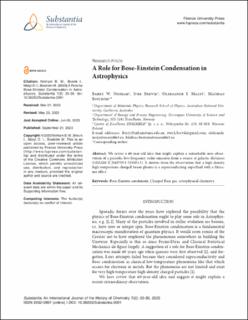| dc.contributor.author | Ninham, Barry W. | |
| dc.contributor.author | Brevik, Iver Håkon | |
| dc.contributor.author | Malyi, Oleksandr I. | |
| dc.contributor.author | Boström, Mathias | |
| dc.date.accessioned | 2024-01-15T15:52:30Z | |
| dc.date.available | 2024-01-15T15:52:30Z | |
| dc.date.created | 2023-06-27T14:30:34Z | |
| dc.date.issued | 2023 | |
| dc.identifier.citation | Substantia. 2023, 7 (2), 35-39. | en_US |
| dc.identifier.issn | 2532-3997 | |
| dc.identifier.uri | https://hdl.handle.net/11250/3111604 | |
| dc.description.abstract | We revive a 60-year-old idea that might explain a remarkable new observation of a periodic low-frequency radio emission from a source at galactic distances (GLEAM-X J162759.5-523504.3). It derives from the observation that a high-density high-temperature charged boson plasma is a superconducting superfluid with a Meissner effect. | en_US |
| dc.language.iso | eng | en_US |
| dc.publisher | © 2023 Firenze University Press | en_US |
| dc.rights | Navngivelse 4.0 Internasjonal | * |
| dc.rights.uri | http://creativecommons.org/licenses/by/4.0/deed.no | * |
| dc.title | A Role for Bose-Einstein Condensation in Astrophysics | en_US |
| dc.title.alternative | A Role for Bose-Einstein Condensation in Astrophysics | en_US |
| dc.type | Peer reviewed | en_US |
| dc.type | Journal article | en_US |
| dc.description.version | publishedVersion | en_US |
| dc.source.pagenumber | 35-39 | en_US |
| dc.source.volume | 7 | en_US |
| dc.source.journal | Substantia | en_US |
| dc.source.issue | 2 | en_US |
| dc.identifier.doi | 10.36253/Substantia-2091 | |
| dc.identifier.cristin | 2158751 | |
| cristin.ispublished | true | |
| cristin.fulltext | original | |
| cristin.qualitycode | 1 | |

